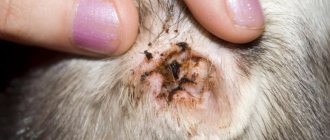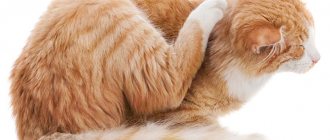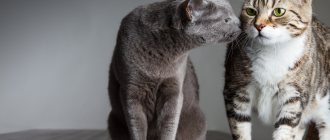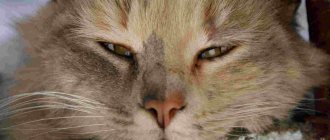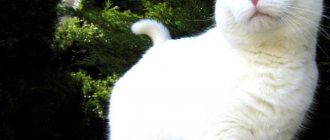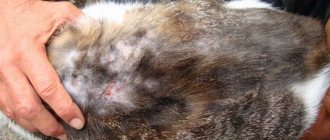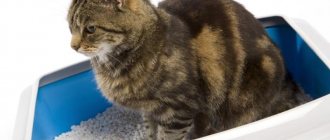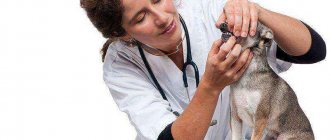Complete list of dental diseases in cats
Most dental pathologies in cats are similar to humans, so treatment methods are not much different.
To easily distinguish dental diseases in cats, you should carefully familiarize yourself with the photos and symptoms of each of them. Among the pathologies in the oral cavity, gum (periodontal) diseases can be identified, which are manifested by inflammation of the tissues of the surrounding teeth. The cause of such ailments is poor oral hygiene, infections, and a large accumulation of various bacteria in the form of plaque at the border of the tooth and gum. There are two periodontal diseases – periodontitis and gingivitis.
https://www.youtube.com/watch?v=ytpressru
The endodontic category of dental ailments includes diseases that directly affect the tooth itself: tartar, caries, plaque, pulpitis, osteomyelitis, etc. The causes may be tooth decay, for example due to caries, as well as trauma to the face and jaws.
Among the problems with the growth and evolution of teeth, it is advisable to note a broken bite, abnormal development of teeth and defects in tooth enamel, which are often hereditary.
About dental problems in cats
So, pain in the masticatory organs is a consequence of their disease. To prevent this, the owner must have information about factors that can provoke dental disease:
- Plaque.
Over time, a gray-yellow layer appears on a cat’s permanent teeth, which consists of bacteria and food particles. To avoid the appearance of plaque, it is necessary to give cats cleansing biscuits, chewing toys, and regularly clean their chewing organs. - Tartar.
It is a consequence of the fact that plaque is not removed. The substance, which was soft for the time being, hardens, the deposits become porous, and they are teeming with bacteria. The stone first appears at the base of the tooth, grows towards the root and penetrates upward under the gum. Over time, the chewing organ becomes completely covered with stone. If you do not remove it, you can easily lose the tooth. It is also possible to develop chronic gum inflammation. Veterinarian dentists remove tartar with a special spatula or ultrasound, depending on the severity of the problem. Sometimes, if everything is not so bad, dissolving gels can also deal with the stone. - Caries
. This disease is the decay of bone tissue. The causes of caries are mechanical damage to the enamel, tartar, chaotic nutrition, deficiency of fluoride, iodine, and vitamin B in the cat's body. Dental pathology is dangerous because it quickly spreads to neighboring teeth and the entire mouth. Carious teeth in cats must either be treated or removed. - Osteomyelitis.
The disease develops due to untreated caries or infections. A feature of osteomyelitis is the formation of a cavity filled with pus on the gum. It leaks out over time. The pain makes the cat refuse food - it loses weight. Osteomyelitis requires surgical intervention by a veterinary specialist. In such cases, he opens the fistula, removes pus from the cavity, and treats it with an antiseptic. - Periodontitis.
This is an inflammation of the tooth root and adjacent soft tissues. The disease is accompanied by severe pain and the cat's refusal to eat. There is a foul odor coming from her mouth. If your pet's teeth are falling out, the cause may be periodontitis. After all, inflamed tissues cannot hold the root, which is destroyed - the tooth becomes loose and falls out. - Gingivitis.
This is hyperemia, bleeding gums, the appearance of ulcers and cracks on them. The cause of gingivitis can be a disease of the internal organs or tartar. Treatment of this disease in cats consists of using folk remedies, for example, irrigation with a decoction of oak bark and chamomile. In this case, veterinarians use Dentavedin gel.
Dental diseases in cats and cats are a common phenomenon. In the natural environment, animals clean their teeth mechanically, gnawing cartilage and eating raw meat. Domestic cats do not have this opportunity, and they live twice as long as stray cats. Therefore, their teeth are more often exposed to diseases. Noticing them in time and seeking medical help is the task of every responsible owner.
A bad tooth in a pet is an infection of the oral cavity and the body as a whole. When a cat has a toothache, emergency measures must be taken. To properly care for an animal, you need to know how many teeth it has in its mouth, what condition they should be in, and what the symptoms of toothache are.
Why dental care is important
Just a couple of decades ago, caring for cat teeth in our country was perceived as a fad. Now both veterinarians and breeders are talking about the need for regular cleaning of the pets’ mouth. Why is it important to monitor your cat’s condition?
After eating, plaque forms on the surface of the tooth enamel. If it is not removed, it will eventually transform into stone. The latter not only does not look aesthetically pleasing, but also leads to gum inflammation.
Against the background of inflammation and proliferation of pathogenic microflora, the entire body begins to suffer. The cat develops problems not only with the oral cavity, but also with the stomach, liver, and intestines.
Due to the large number of pathogenic bacteria, immunity is reduced. The animal suffers from regular colds and becomes more susceptible to infections. Which increases the risk of contracting feline leukemia or immunodeficiency virus.
Without regular cleanings, the enamel is damaged by caries. What causes teeth to crumble or break off. In advanced cases, they begin to stagger and the animal feels uncomfortable eating. Eventually, the diseased teeth fall out and the cat requires a special diet of pureed food.
If you don't brush your cat's teeth, it primarily leads to oral diseases. The most common ones are:
- Tartar is a dark plaque on the teeth. It provokes various inflammatory processes in the oral cavity. Left untreated it leads to tooth loss.
- Caries is the destruction of the tooth structure. It begins with darkening of the tooth enamel and an unpleasant odor from the mouth. Subsequently, a cavity forms in the affected tooth. It breaks off and subsequently falls out.
- Periodontitis is an inflammation of the soft tissues of the gums that can affect the root of the tooth. The disease is manifested by a foul odor from the mouth and increased production of saliva. The cat refuses to eat, and the animal’s body temperature rises.
- Gingivitis is a pathology of the gums that develops against the background of oral infections. It is characterized by an unpleasant odor from the mouth and reddening of the gums.
- Stomatitis is inflammation of the oral mucosa. It is accompanied by redness of the gums, they may also acquire a bluish tint. In some cases, ulcers form. A gray or whitish coating forms on the affected areas. The animal refuses to eat and experiences extreme thirst.
- Osteomyelitis is an inflammation in the oral cavity that develops against the background of caries. The first symptoms are redness of the gums around the tooth. Then a seal appears in its place. After which an abscess develops, which spontaneously opens. And in its place a fistula forms.
All diseases of the oral cavity and teeth in cats require a professional approach. Self-treatment is dangerous for the pet’s life.
Oral care is important not only for people, but also for our little brothers. In order for your pet to live next to you for a long time, do not neglect regular brushing of teeth and gums.
Stages of caries development
Caries in a cat develops in several stages:
– spotted caries – some areas of the tooth begin to darken;
– superficial caries – depressions appear on the surface of a cat’s tooth and turn black;
– medium caries – the destruction of the dentin structure, that is, the hard tissue of the tooth, begins;
– deep caries – inflammation of the pulp, that is, the internal tissues of the tooth, begins, and pulpitis develops.
If caries gets so bad that it reaches the last stage, it threatens tooth loss. And if you don’t intervene here, then, in addition to tooth loss, the inflammation can spread to the gums, which will lead to serious complications and require complex treatment.
Additional plaque prevention
What to do if your cat has caries? Caries needs to be treated like any other disease. First, you need to contact a knowledgeable specialist who will sanitize the oral cavity, perform the necessary surgical interventions, and prescribe all the procedures and medications necessary for recovery.
If your pet suffers only from the superficial stage, a 4% solution of sodium fluoride or silver nitrate is used for treatment. In the case of all other stages, the veterinarian, unfortunately, can only offer tooth extraction. Before removal, the tooth is naturally anesthetized (with a 1% solution of novocaine).
Otherwise, if you leave the teeth in the same condition, your pet faces the risk of caries spreading throughout the entire jaw, and as a result, the complete destruction of most of the teeth.
To minimize the possibility of caries in a cat, the owner should properly monitor its health. This applies to regular brushing of teeth (2-3 times a week). And don’t forget to use only a special toothbrush and toothpaste! The next point is proper and balanced nutrition for the cat.
Try to diversify your pet's menu as much as possible, add vitamin complexes in tablets to your food. As for the menu itself, remove food from it “from the common table.” The cat should eat solid food with plenty of bones, cartilage, etc. If you want to feed your cat other food, choose solid store-bought food.
In addition, veterinarians remind you to regularly visit the doctor and examine your cat to identify possible signs of developing disease. This is especially true when you notice any changes in the cat’s oral cavity. Still, preventing any disease is much easier than treating it.
- Incorrect position of teeth.
- Diet.
- Infectious diseases.
- Availability of dental care.
- The environment in the mouth - changes in microflora and the presence of bacteria can significantly influence the development of diseases.
- Genetics – Some cats may be more predisposed to dental disease than others.
- The pet rubs its muzzle with its paw or persistently rubs its cheek against the furniture.
- There is an unpleasant odor from the mouth.
- The gums become red and inflamed.
- One or more teeth change color.
- The pet does not allow you to touch its cheek, and shows aggression if the owner tries to look into its mouth.
- Depending on how many of your cat's teeth hurt, she may either refuse to eat completely or eat with caution (chewing on one side, dropping pieces, chewing food more slowly than usual).
- When the pain is severe, the cat behaves restlessly, scratching its cheek with its paw, meowing, or sitting in a frozen position with its jaw slightly open. Drooling may increase.
- heredity;
- type of feeding;
- digestive characteristics, etc.
- Having your cat eat only soft food and food from the table.
- Improper oral hygiene.
- Some types of metabolic disorders, primarily salt ones.
- Incorrect position and increased roughness of teeth.
- Features of the breed. Cats of “short-nosed” breeds (Persians, Exotics, etc.) almost certainly have deviations in the positioning of their teeth, sometimes very significant. Their jawbones are often too small to accommodate all the teeth properly, causing the teeth to be too crowded and misaligned.
- Retention of baby teeth. In some cats, baby teeth may remain in the jaw while permanent teeth begin to grow. If the permanent tooth cannot push out the baby tooth during growth, it may grow at an incorrect angle, taking on a position unusual for a normal tooth.
- Trauma or congenital anomalies. Sometimes a cat's jaws can be abnormally shaped due to birth defects (such as underbites or overbites) or due to injury (such as a broken jaw). An improperly shaped jaw can also cause teeth to move into incorrect positions.
- Difficulty in eating and chewing food.
- Mechanical damage to the mucous membrane of the lips, cheeks, gums, tongue.
- Diseases of the digestive system.
- Polyodontia or polydentia.
- Oligodontia or reduced number of teeth in the mouth.
- Convergence is excessive convergence of the roots of the teeth.
- Retention – the tooth is not in the jaw line.
- Divergence is the divergence of tooth roots.
- Underbite. This is the case when the upper jaw is longer than the lower jaw, that is, the upper incisors overlap the lower ones without touching.
- Snack. It is the complete opposite of the above. The lower jaw protrudes beyond the upper jaw, like a bulldog.
- Twisted mouth. This is the most severe case of malocclusion. In this situation, there is uneven growth of one side of the jaw, which leads to its distortion. This developmental defect leads to difficulty grasping food and tearing it.
- Mechanical damage to the enamel.
- Poor nutrition.
- Tartar.
- Metabolic dysfunction.
- Deficiency of iodine, fluorine, vitamin B, molybdenum in the body.
- Spotted.
- Surface.
- Average dental caries.
- Deep caries.
- Darkening of tooth enamel.
- The appearance of an unpleasant odor from the cat's mouth.
- Over time, a hollow (hole) forms in the diseased tooth.
- Increased salivation.
- Pain when chewing.
- Inflammation of the mucous membrane of the gums.
- Red gums appear around one or more teeth.
- At the level of the lesion, a compacted and painful swelling appears, clearly visible from the outside.
- An abscess develops under the periosteum, usually spontaneously opening inside the oral cavity, less often on the outside of the jaw.
- A fistula is formed through which purulent exudate is released.
- The cat refuses food and quickly loses weight.
- Regional lymph nodes are enlarged and painful.
- Insufficient oral care.
- Infections.
- Metabolic disease.
- Diseases of internal organs.
- Bad breath.
- Salivation.
- Red or swollen gums, especially along the gum line.
- The gums bleed, especially when touched.
- Lack of appetite.
- Regularly inspect the oral cavity, removing stuck pieces of food.
- See a doctor if you notice even minor signs of gum or dental disease.
- Feed your cat a balanced diet (if dry food is used, periodically add oral lines designed to prevent diseases of teeth and gums to the food menu).
The domestic cat, no matter how affectionate and playful it is, is, first of all, still a predator with well-developed fangs, which are designed for successful hunting. At the same time, dental diseases in cats can provoke many problems with the health of the whole body: the digestive organs (intestines and stomach) suffer, the immune system weakens. It is for this reason that caring owners of furry pets should closely monitor the cat’s oral health.
Dental diseases in cats
READ Why do cats lose their whiskers? — Cat Oddball
Dental diseases at the primary stage of their development are quite difficult to diagnose. However, understanding what the normal structure of a cat’s dental system should be will help you notice the problem in time and immediately begin treatment measures, thereby avoiding complications.
Important! The occurrence of any disorders in the oral cavity may indicate the onset of an inflammatory process caused by infection or the proliferation of pathogenic bacteria.
Baby teeth erupt in newborn kittens a few weeks after they are born. After 6-7 weeks, they begin to give way to permanent ones: this stage is normally virtually invisible, but in some individual cases it can cause significant discomfort to the animal. At this time, the cat’s body produces a special substance - lysozyme, which helps stop the development of infection, providing an antimicrobial effect. An insufficient amount of lysozyme can provoke a disruption of the bacterial background, which will provoke the occurrence of tartar and caries.
A healthy domestic cat normally has 30 teeth - 16 on the upper jaw and 14 on the lower:
- Incisors. Small teeth located in front on both jaws, 6 pieces each. The animal does not use them for chewing food - they serve to fix prey in the mouth or hold large pieces of food.
- Fangs. The longest and sharpest teeth are used by wild animals to kill their prey. The canines are quite powerful because they have the deepest root canals. On the jaws of cats there is one fang on both sides.
- Premolars. Small molars are suitable for grinding food, particularly meat. All cats have six upper and four lower premolars with roots of different lengths.
- Molars. Also designed for grinding food.
The structure of the cat's dental system
All teeth in cats, like in humans, are theoretically susceptible to mechanical damage, for example, when a tooth breaks due to a head injury or as a result of a strong blow. However, most often, pathologies of the dental system in cats have the following causes:
- Genetic failure. Often, defects in the structure of the oral cavity and an inherent hereditary factor of predisposition to diseases are found in selective breeds of cats.
- Pathologies of bite and enamel. In some breeds, several permanent teeth are missing from birth, which leads to accelerated wear of the remaining teeth and thinning of the enamel.
- Ecology - the influence of chemicals and carcinogens in air, water and food.
- Infections that can cause abscesses leading to tooth loss.
- Lack of oral hygiene. If the owner does not promptly eliminate plaque on his pet’s teeth, its layer is transformed into hard tartar, which can damage the gums and lead to the appearance of even more serious pathologies.
READ The cat has cold paws: we identify the causes and prevent the consequences
Types of malocclusion
Since there are many causes of dental disease in cats, it is advisable for the owner to closely monitor his pet in order to notice the problem at the initial stage of its development. The most common signs of dental disease in cats are:
- red, sore, or swollen gums;
- the presence of an abscess or lump on the animal’s jaw;
- pungent and unpleasant odor from the mouth;
- loose or worn down teeth;
- increased salivation.
Attention! It is important to remember that the symptoms of dental diseases usually appear gradually, so attentive owners always have a chance to notice the pathology in time and begin treatment, preventing the development of the disease.
Causes of dental disorders
Veterinarians note that diseases of teeth and gums often appear in older cats and are associated with irreversible age-related processes. If the cat is young and already has rotten black and brown teeth, then most likely the problem lies in serious internal disorders.
The reasons that become the trigger for toothache and enamel damage are:
- Genetic features. Some breeds are prone to developing dental disease quickly. Therefore, it is important to regularly examine the chewing teeth, canines, incisors, and the entire jaw.
- Chronic infections. Often cause dental problems. Constantly occurring inflammatory processes lead to a decrease in immune strength, as a result of which the body is unable to cope normally with pathogenic microflora. A cat's teeth quickly deteriorate, turn yellow and rot.
- Incorrect position of teeth. If a canine or premolar is crooked or positioned incorrectly, it will be difficult for your cat to chew rough food and remove any debris. As a result, the tooth gradually deteriorates and rots.
- Unbalanced diet. Poor nutrition is a common cause of tooth decay in cats. If the diet does not contain enough nutrients, vitamins, micro- and macroelements, the cat’s teeth are one of the first to begin to deteriorate.
- Injuries. If a cat's jaw is severely traumatized and damaged, the teeth may begin to decay. To help your pet avoid complications, it is better to show it to a veterinarian, who will tell you what to do in this case.
Rules for brushing teeth
The cat, like its owner, should have its own toothbrush and toothpaste. The use of human accessories is prohibited.
What you need for cleaning:
- A special toothbrush or finger cap.
- Toothpaste for animals.
- Cotton swabs can be used to replace a brush, but they are less convenient.
When choosing a toothbrush, pay attention to the composition of the bristles. It is better if they are made from natural raw materials. They should be soft so as not to injure the gums. The working surface of the brush should not be too large. It is important that it moves freely in the cat paste.
Hygiene procedures begin only when the pet is in a good mood and calm. The animal must be well-fed and healthy. During illness, brushing your teeth is postponed. It begins with affection and stroking, kind words. It is important that the cat willingly sits in your arms.
The procedure is carried out once every ten days. For representatives of some breeds (British Shorthair, Persian) more often. The algorithm of actions is as follows:
- The animal is placed on your knees or on a table, turning its muzzle towards you.
- If the cat shows dissatisfaction and tries to escape, he is wrapped in a terry towel. This must be done gently, without causing pain to the pet.
- Gently spread the cat's jaws. To do this, press between the teeth on both sides with the thumb and forefinger. The cat will reflexively open its mouth.
- It is forbidden to pull the lower jaw downwards.
- The teeth are brushed with gentle massage movements, it is important not to injure the gums.
- The brush is moved according to the same principle as when brushing your own teeth. It is advanced from the gum to the upper surface of the tooth.
- Cleaning begins with the molars, then gradually moves to the front teeth.
It is important not to delay the process, but to do everything quickly and accurately. If you are unsure of your own abilities, consult a veterinarian. He will conduct the first cleaning and give useful recommendations.
The sooner you start teaching your kitten about oral hygiene, the better. The process should not be rushed; it should resemble a game and not cause discomfort to the pet. There are no strict rules; each cat owner chooses methods taking into account the cat’s character.
Approximate procedure:
- The index finger of the right hand is wrapped in gauze or a bandage and soaked in meat broth.
- A well-fed and calm kitten is picked up, stroked, and spoken to affectionately.
- The wrapped finger is allowed to be sniffed by the kitten, and it is allowed to bite it lightly. It is important not to allow your pet to bite into it with its teeth.
- Every day, little by little, move your finger into the cat’s mouth, scratching the gums and teeth with it.
- After the animal gets used to the manipulation, the meat broth is replaced with toothpaste for cats.
Instead of your finger, you can immediately use a toothbrush for cats. It is important to take your time, be patient and be gentle with your pet. Even small “achievements” during the learning process are rewarded in a way familiar to the kitten.
Determining age by teeth
Kittens are born toothless. The deciduous incisors begin to erupt first; this occurs at approximately 2–5 weeks of a baby’s life. At 3 weeks, baby fangs are already growing, this process lasts up to 8 weeks. 2 - 3 weeks after their appearance, the primary premolars begin to erupt. At the age of 3 - 6 months, kittens change their milk teeth to permanent ones. As a rule, by the age of one year a young animal has erupted 30 teeth: 16 on the upper jaw and 14 on the lower jaw.
Determining the approximate age of a pet by its teeth is not so difficult and even the owner can do it:
- If 30 snow-white teeth are found in the mouth without signs of pigmentation or abrasion, then we can confidently say that the animal is 1 year old.
- At the age of 1.5 years, yellowness appears.
- At 2 years of age, the middle incisors of the lower jaw begin to wear off, and a clearly visible yellow discoloration appears. At the same time, tartar formation may occur.
- At 3 years of age, wear of the central incisors located on the lower jaw is already noticeable.
- If, upon examination, the abrasion of the fangs is noticeably expressed, then this condition is typical for an animal 5 years old. At this age, a dark yellow plaque is clearly visible on all teeth.
- After 5 years of age, the chewing surface of the incisors is destroyed.
- Wearing of the upper and lower incisors can be seen in a cat at the age of 7 - 8 years.
- If not a single incisor is found in the animal’s mouth, then the animal is from 12 to 14 years old.
- After 14 - 15 years, fangs fall out. How many teeth a cat will have after 15 years depends largely on nutrition and proper hygienic care of the animal’s mouth.
The older the pet is, the more pronounced the yellow coating is. Tartar formation occurs already at the age of one and a half years and largely depends on the type of diet and proper dental care. Even a specialist often finds it difficult to determine the exact age of incisors and canines due to the fact that improper care or lack thereof leads to premature wear.
Self-examination of the cat's oral cavity
Regular examination of the condition of your cat's teeth and gums helps prevent the development of periodontal disease, gingivitis, tartar and other oral diseases. It is carried out at least twice a month.
The procedure begins when the pet is in a calm state. If the cat is aggressive or acting out, you need to wait.
https://www.youtube.com/watch?v=ytaboutru
Before examining the oral cavity, look at the cat or scratch behind the ear. The owner should be affectionate and calm.
What do you pay attention to first:
- Color of tooth enamel. In a healthy cat, it ranges from white to cream with a slight creamy coating.
- The presence of a rash or wounds, inflammation on the gums. Normally, the mucous membrane is pink in color without damage.
- Presence of stains or tartar on the enamel. A healthy animal does not have them.
- Smell from the mouth. A putrid, unbearable odor is an unhealthy symptom.
READ Why do cats lose their whiskers? — Cat Oddball
Excessive salivation in your pet should also alert you. During the examination, the condition of the teeth and gums is also checked by lightly pressing on them with a finger. There are normally no painful sensations; touching does not cause noticeable discomfort to the cat.
Broken, rotting teeth require a visit to the veterinarian. Don't ignore crumbling tooth enamel.
Tartar
Tartar is a porous layer that occurs as a result of untimely removal of plaque. The place where the disease appears is the base of the tooth, after which the stone begins its journey to the root, penetrating deep into the gum, and upward, gradually enveloping the tooth from all sides.
The reasons for the formation of tartar are:
- feeding exclusively soft food or a menu “from the table”;
- insufficient oral hygiene;
- metabolic disorders, including salt metabolism;
- increased roughness and abnormal position of teeth.
Interesting. Cats have a breed-specific predisposition to the formation of tartar. The Persian and British breeds, as well as Scottish folds, are most sensitive to this disease.
Signs of the disease include the presence of hardened brownish-yellow growths on the tooth, bad breath, bleeding gums and itching.
Treatment of tartar is based on its complete removal . Based on the severity of the tartar covering the teeth, the veterinarian selects the optimal cleaning method. In mild situations, ordinary dissolving gels can help, but often a special spatula or ultrasound is used to remove hard tartar. For animals with increased nervousness and those in which the stone has penetrated under the gum, the doctor gives anesthesia for 15-20 minutes.
To prevent stone formation, you should carefully monitor your pet's oral hygiene and diet.
Anomalies in the development of teeth and bite
The presence of anomalies in the development of teeth or bite can cause mechanical injury to the mucous membrane of the cheeks, lips, tongue and gums, pathologies of the gastrointestinal tract, as well as complicated eating and chewing of food.
Cats often have such anomalies as:
- oligodontia – reduced number of teeth in the mouth;
- polyodontia – multiple teeth;
- retention - the location of the tooth is not in the jaw row;
- convergence - strong convergence of the roots of the molars;
- divergence – excessive divergence of tooth crowns;
- progeny (pike bite) - shortening of the upper jaw, when the incisors of the lower jaw protrude forward and do not meet the incisors of the upper jaw;
- prognathia (carp bite) – shortening of the lower jaw, when the upper jaw protrudes beyond the border of the lower jaw;
- lopsided mouth is a severe case characterized by uneven growth of one side of the jaw.
Such anomalies are associated with congenital disorders of growth and development of the jaws, delayed replacement of primary teeth, retention of primary teeth, etc. The main symptom of unnatural development of teeth and bite is difficulty in eating and chewing food.
In certain cases, tooth extraction (removal) may be required, and to prevent pathologies in the development of teeth and occlusion, one must carefully monitor the replacement of baby teeth, wear of incisors, and, if necessary, remove retained baby teeth.
Diagnostics
If you suspect such a problem, the animal should be shown to a specialist.
If you can tell from their behavior that your cat has a toothache, it is important to find out the root cause of the pathology and, if necessary, begin to treat the disease. To determine an accurate diagnosis, you need to visit a veterinarian. During the initial examination, the doctor examines the oral cavity and teeth, and asks the owner about the animal’s behavior. To determine the extent of the pathological process, radiography may be prescribed. To cure a disease, you need an integrated approach, so self-medication is contraindicated.
Osteomyelitis of teeth in cats
Odontogenic osteomyelitis is an inflammatory disease of the tooth, gums, alveoli, bone marrow and bone wall, caused by complications of purulent pulpitis, caries and periodontitis.
With osteomyelitis, the following clinical picture is observed:
- redness of the gums in the affected area, painful sensation and difficulty chewing;
- then a painful swelling develops, sometimes facial asymmetry is observed;
- as acute purulent inflammation progresses, an abscess develops and fistulas form through which purulent fluid is released;
- teeth become wobbly, and a strong pain reaction is felt: cats chew food with difficulty or refuse it altogether, losing body weight;
- Regional lymph nodes are enlarged and painful.
Before visiting the veterinarian, the oral cavity is irrigated with a solution of potassium permanganate; other treatment methods are prescribed exclusively by the doctor. At the initial stage of development of osteomyelitis, you can get by with antibiotics, sulfonamide drugs and immunostimulating agents. In other cases, tooth extraction is required with opening of the fistula, removal of purulent fluid from its cavity and treatment with an antiseptic solution.
In order to prevent odontogenic osteomyelitis, you should regularly examine your pet's oral cavity to identify diseased teeth or pathogenic processes that can provoke the disease.
Read the full article about feline osteomyelitis.
Treatment: what to do?
What to do if your pet has caries?
He definitely needs to be treated! First of all, you need to contact a knowledgeable specialist who will conduct a professional examination of the cat’s oral cavity. It is not recommended to treat your cat yourself at home. Only veterinarians should fix dental problems.
When the disease is detected at the very beginning, the specialist will prescribe medications to the cat that contain sodium fluoride and silver nitrate. If the caries lesion is deep, then tooth extraction will be required.
There are situations when it is not possible to get an appointment with a veterinarian, in which case make a chamomile decoction and rinse the animal’s mouth with it as often as possible. If there is tartar, you can scrub it off with a piece of gauze soaked in a weak solution of hydrogen peroxide, or with a toothbrush with soft bristles.
Important!
All actions that are performed at home will not bring effective treatment. Remember that every day of delay will lead to more destruction of the enamel!
Periodontitis of teeth
Periodontitis is a common disease in veterinary practice, consisting of inflammation at the apex of the tooth root. The disease often occurs in cats after two years of age and can be chronic, acute, purulent and aseptic in nature.
The causes of inflammation can be mechanical damage to the gums, tartar and plaque, removal of molars while ignoring antiseptic and aseptic rules, blows to the dental crown, foreign objects and particles of roughage entering the space between the tooth and gum, diseases of the gums and jaws, caries, pulpitis, etc.
Signs of periodontitis are:
- halitosis;
- difficulty eating, lack of appetite, weight loss;
- painful sensations when touching a tooth;
- swelling of the gums in the form of a roller (with a purulent form of the disease);
- mobility of the affected tooth.
In case of periodontitis, the oral cavity is sprayed several times a day with disinfectant solutions of furatsilin, potassium permanganate or 2-5% alum solution. The gum along the ring of the affected tooth is treated with iodine-glycerin.
To prevent the occurrence of periodontitis, you should promptly remove tartar, remove plaque from your pet’s teeth, and also monitor the general condition of the mouth.
Prevention and care
To prevent the occurrence of dental pathologies, veterinarians recommend starting to monitor your cat’s oral cavity from an early age. Kittens should eat well; their diet must include complete protein in the form of white meat, cottage cheese, eggs, and dairy products. Specialists at the Zoovet veterinary clinic recommend periodically giving your pet special dietary supplements that replenish the deficiency of useful micro- and macroelements and vitamins.
Don't forget about keeping your mouth clean. To prevent the development of pathologies such as caries, gingivitis, periodontitis, and tartar, it is recommended to brush your pet’s teeth with a special brush and toothpaste 1-2 times a week. The animal removes plaque on its own using roughage. But hard foods should not predominate in the diet, because they injure the gums, which leads to dental diseases.
Gum diseases (periodontitis, gingivitis)
Gingivitis is an inflammation of the gums that does not affect the teeth. Most often, the cause of gingivitis is a lack of hygiene, because many owners ignore the requirement of veterinarians to clean the cat’s mouth monthly.
Pathogenic microflora actively multiplies on the gums, which leads to the formation of a whitish coating, redness, and swelling. Gingivitis can be suspected based on the following signs:
- the cat’s gums look reddened or, conversely, too pale;
- ulcers form on the mucous membrane;
- the gums swell, the muzzle may look swollen;
- bleeding appears;
- there is an unpleasant odor coming from the mouth.
Without treatment, gingivitis can develop into periodontitis - an inflammatory process in the periodontal tissues, during which the alveolar process of the jaw is destroyed. One of the first symptoms of periodontitis is loose teeth and bleeding gums. Then a purulent fistula forms in the gum near the tooth, and purulent exudate begins to leak from the cat’s mouth. Without treatment, the animal's teeth fall out.

